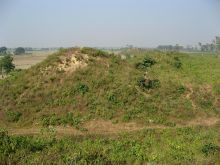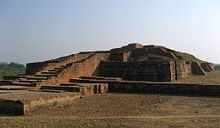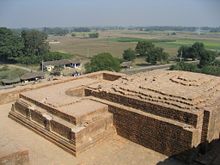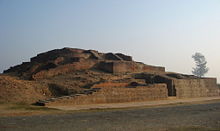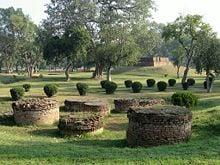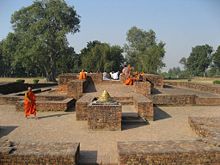Difference between revisions of "Sravasti" - New World Encyclopedia
Dan Davies (talk | contribs) |
Dan Davies (talk | contribs) m |
||
| Line 33: | Line 33: | ||
The ceremony of dedication was one of great splendor. Not only Anāthapindika himself, but his whole family took part. His son with five hundred other youths, his wife with five hundred other noble women, and his daughters Mahā Subhaddā and Cūla Subhaddā with five hundred other maidens attended. Five hundred bankers accompanied Anāthapindika. The festivities in connection with the dedication lasted for nine months.<ref>J.i.92ff</ref> | The ceremony of dedication was one of great splendor. Not only Anāthapindika himself, but his whole family took part. His son with five hundred other youths, his wife with five hundred other noble women, and his daughters Mahā Subhaddā and Cūla Subhaddā with five hundred other maidens attended. Five hundred bankers accompanied Anāthapindika. The festivities in connection with the dedication lasted for nine months.<ref>J.i.92ff</ref> | ||
| − | The vihāra has been typically referred to as '''Jetavane Anāthapindikassa ārāma''' ([[Pali]], meaning: in Jeta Grove, Anathapindika's Monastery). The Commentaries <ref>MA.ii.50; UdA.56f, etc.</ref> state that this was deliberate<ref>at the Buddha's own suggestion, pp. 81-131 | + | The vihāra has been typically referred to as '''Jetavane Anāthapindikassa ārāma''' ([[Pali]], meaning: in Jeta Grove, Anathapindika's Monastery). The Commentaries <ref>MA.ii.50; UdA.56f, etc.</ref> state that this was deliberate<ref>at the Buddha's own suggestion, pp. 81-131 <!-- Beal: op. cit., ii.5 and Rockhill: p. 49—></ref> that the names of both earlier and later owners might be recorded and that people might be reminded of two men, both very generous in the cause of the religion, so that others might follow their example. The vihāra is sometimes referred to as Jetārāma. <ref>e.g., Ap.i.400</ref> |
===Description of ancient Jetavana=== | ===Description of ancient Jetavana=== | ||
====Inside Jetavana==== | ====Inside Jetavana==== | ||
[[Image:Angulimalastupa.jpg|thumb|right|220px|[[Stupa]] of [[Angulimala]].]] | [[Image:Angulimalastupa.jpg|thumb|right|220px|[[Stupa]] of [[Angulimala]].]] | ||
| − | Some of the chief buildings attached to the Jetavana are mentioned in the books by special names, viz., Mahāgandhakuti, Kaverimandalamāla, Kosambakuti and Candanamāla. <ref>SNA.ii.403</ref> Other buildings are also mentioned - e.g., the Ambalakotthaka-āsanasālā.<ref>J.ii.246</ref> According to Tibetan sources the vihāra was built according to a plan sent by the devas of Tusita and contained sixty large halls and sixty small. The Dulva also gives details of the decorative scheme of the vihāra.<ref>Rockhill: op. cit.48 and n.2</ref> | + | Some of the chief buildings attached to the Jetavana are mentioned in the books by special names, viz., Mahāgandhakuti, Kaverimandalamāla, Kosambakuti and Candanamāla. <ref>SNA.ii.403</ref> Other buildings are also mentioned - e.g., the Ambalakotthaka-āsanasālā.<ref>J.ii.246</ref> According to Tibetan sources the vihāra was built according to a plan sent by the devas of Tusita and contained sixty large halls and sixty small. The Dulva also gives details of the decorative scheme of the vihāra.<!--<ref>Rockhill: op. cit.48 and n.2</ref>—> |
All these were built by Anāthapindika; there was another large building erected by Pasenadi and called the Salalaghara.<ref>DA.ii.407</ref> Over the gateway lived a guardian deity to prevent all evildoers from entering.<ref>SA.i.239</ref> Just outside the monastery was a rājayatana-tree, the residence of the god Samiddhisumana.<ref>Mhv.i.52f; MT 105; but see DhA.i.41, where the guardian of the gateway is called Sumana</ref> In the grounds there seems to have been a large pond which came to be called the Jetavanapokkharanī. <ref>AA.i.264; here the Buddha often bathed; J.i.329ffIs this the Pubbakotthaka referred to at A.iii.345? But see S.v.220; it was near this pond that Devadatta was swallowed up in Avīci (J.iv.158)). </ref> | All these were built by Anāthapindika; there was another large building erected by Pasenadi and called the Salalaghara.<ref>DA.ii.407</ref> Over the gateway lived a guardian deity to prevent all evildoers from entering.<ref>SA.i.239</ref> Just outside the monastery was a rājayatana-tree, the residence of the god Samiddhisumana.<ref>Mhv.i.52f; MT 105; but see DhA.i.41, where the guardian of the gateway is called Sumana</ref> In the grounds there seems to have been a large pond which came to be called the Jetavanapokkharanī. <ref>AA.i.264; here the Buddha often bathed; J.i.329ffIs this the Pubbakotthaka referred to at A.iii.345? But see S.v.220; it was near this pond that Devadatta was swallowed up in Avīci (J.iv.158)). </ref> | ||
Revision as of 18:05, 8 December 2008
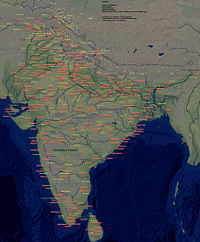
Coordinates:
Srāvastī or Sāvatthī (Hindi: श्रावस्ती), one of the six largest cities in India during Gautama Buddha's lifetime, was located in the fertile Gangetic plains in the present day's Gonda district of Uttar Pradesh. Jetavana monastery was a famous monastery close to Savatthi.
Origin of Sravasti
According to the epic Ramayana, Sravasti was a new city created for Lava (the son of Raghava Rama). Rama divided his Kosala Kingdom into two parts. He installed his son, Lava, at Sravasti and another son, Kusha, at Kushavati.
According to the Mahabharata, the legendary king Shravasta founded Sravasti, naming the city "Savatthi" after the sage Savattha who practiced there. According to another tradition, at a caravanserai there people who greet and ask each other what they had ("Kim bhandam atthi?"). They then replied "Sabbam atthi" meaning "we have all things", as in everything. The city took on the reply as its name.[1].
Sravasti in the Buddha's time
Savatthi, located on the banks of the river Aciravati (now called the Rapti river), had been the capital city of the kingdom of Kosala. Its king, Pasenadi, had been a disciple of Buddha. A beautiful city, the economy enjoyed abundant agriculture and a diversity of crafts. Buddhaghosa states [2] that, in the Buddha's time, fifty seven thousand families dwelled in Savatthi. It had been the chief city in the country of Kasi Kosala, three hundred leagues in length with eighty thousand villages. He stated the population of Sávatthi to have been 180 million [3]. The road from Rajagaha to Savatthi passed through Vesali. The Parayanavagga [4] lists the resting places between the two cities: Setavya, Kapilavatthu, Kusinara, Pava and Bhoganagara. Further on, a road ran southwards from Savatthi through Saketa to Kosambi. Between Saketa and Savatthi was located Toranavatthu[5].
The Buddha passed the greater part of his monastic life in Savatthi. He first visited Savatthi at the invitation of Anathapindika, whom he met in Rajagaha. Jetavana and the Pubbarama had been the main monasteries in Sravasti. Pasenadi built Rajakarama monastery, opposite Jetavana, in Savatthi. Andhavana, a dark forest where some monks and nuns resided, lay close by the city. A fishing village of five hundred families lay outside the city gate of Savatthi.[6] Anathapindika, Visakha, Suppavasa and Pasenadi had been the chief patrons of the Buddha in Savatthi.[7]. When Bandhula left Vesali, he came to live in Savatthi.
According to Woodward, [8] of the four Nikayas, 871 suttas had been preached in Savatthi; 844 of those in Jetavana, twenty three in the Pubbarama, and four in the suburbs of Savatthi. Those suttas are made up of six in the Digha Nikaya, seventy five in the Majjhima Nikaya, 736 in the Samyutta Nikaya, and fifty four in the Anguttara Nikaya. The Commentaries state that the Buddha spent twenty five rainy seasons in Sávatthi, with twenty spent elsewhere. Of the twenty five rainy seasons Buddha lived in Sravasti[9], he spent nineteen in Jetavana monastery and six in Pubbarama monastery. Buddha spent longer in Sravasti than any other place, giving the most discourses and teachings.
Buddha displayed his supernatural powers to silence those who asserted him incapable of performing supernatural miracles at a place in Savatthi called the Twin Miracle (Pali:Yamaka Patihara). Buddhist commentaries place the scene of each Buddha's Yamaka pátiháriya in Savatthi [10]; Gautama Buddha performed this miracle under the Gandamba tree. The Chinese Pilgrim Hiouen Thsang found the old city in ruins, but recorded the sites of various buildings[11].
Jetavana Monastary
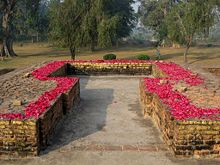
Jetavana had been one of the most esteemed of the monasteries in India during Buddha's lifetime. The second monastery donated to Buddha, after the Veluvana in Rajagaha, Jetavana sits just outside the old city of Savatthi. Buddha gave many teachings and discourses in Jetavana, more than in any other place. Mainly, this is because Buddha spent nineteen (out of forty five) rainy-seasons (also pansah or vassa) at Jetavana, more than any other monastery[12]. After the Migāramātupāsāda (a second monastery erected at Pubbarama, close to Savatthi) had been established, the Buddha would dwell alternately in Jetavana and Migāramātupāsāda, often spending the day in one and the night in the other. [13]
Donation of Jetavana
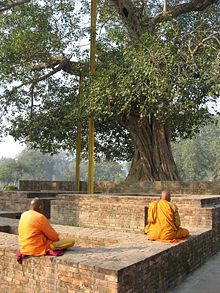
When the Buddha accepted Anāthapindika's invitation to visit Sāvatthi, Anāthapindika, seeking a suitable place for the Buddha's residence, discovered a park belonging to Jetakumāra. [14] When he asked to be allowed to buy it, Jeta replied: "Not even if you could cover the whole place with money." Anāthapindika said that he would buy it at that price, and when Jeta answered that he had had no intention of making a bargain, the matter went before the Lords of Justice, who decided that if the price mentioned were paid, Anāthapindika had the right of purchase.
Anāthapindika had gold brought down in carts and covered Jetavana with pieces laid side by side. (A bas-relief at the Bharhut Tope illustrates that incident.[15] The money brought in the first journey proved insufficient to cover one small spot near the gateway. So Anāthapindika sent his servants back for more, but Jeta, inspired by Anāthapindika's earnestness, offered to give that spot. Anāthapindika agreed and Jeta erected a gateway, with a room over it, there. Anāthapindika built in the grounds dwelling rooms, retiring rooms, store rooms and service halls, halls with fireplaces, closets, cloisters, halls for exercise, wells, bathrooms, ponds, and open and roofed sheds.[16] MA.i.50; UdA.56f states that Anāthapindika paid eighteen crores for the purchase of the site, all of which Jeta spent in the construction of the gateway gifted by him. (The gateway was evidently an imposing structure [17]). Jeta gave, besides, many valuable trees for timber. Anāthapindika himself spent fifty-four crores in connection with the purchase of the park and the buildings erected in it.
The ceremony of dedication was one of great splendor. Not only Anāthapindika himself, but his whole family took part. His son with five hundred other youths, his wife with five hundred other noble women, and his daughters Mahā Subhaddā and Cūla Subhaddā with five hundred other maidens attended. Five hundred bankers accompanied Anāthapindika. The festivities in connection with the dedication lasted for nine months.[18]
The vihāra has been typically referred to as Jetavane Anāthapindikassa ārāma (Pali, meaning: in Jeta Grove, Anathapindika's Monastery). The Commentaries [19] state that this was deliberate[20] that the names of both earlier and later owners might be recorded and that people might be reminded of two men, both very generous in the cause of the religion, so that others might follow their example. The vihāra is sometimes referred to as Jetārāma. [21]
Description of ancient Jetavana
Inside Jetavana
Some of the chief buildings attached to the Jetavana are mentioned in the books by special names, viz., Mahāgandhakuti, Kaverimandalamāla, Kosambakuti and Candanamāla. [22] Other buildings are also mentioned - e.g., the Ambalakotthaka-āsanasālā.[23] According to Tibetan sources the vihāra was built according to a plan sent by the devas of Tusita and contained sixty large halls and sixty small. The Dulva also gives details of the decorative scheme of the vihāra.
All these were built by Anāthapindika; there was another large building erected by Pasenadi and called the Salalaghara.[24] Over the gateway lived a guardian deity to prevent all evildoers from entering.[25] Just outside the monastery was a rājayatana-tree, the residence of the god Samiddhisumana.[26] In the grounds there seems to have been a large pond which came to be called the Jetavanapokkharanī. [27]
The grounds themselves were thickly covered with trees, giving the appearance of a wooded grove (arañña).[28] On the outskirts of the monastery was a mango-grove.[29] In front of the gateway was the Bodhi-tree planted by Anāthapindika, which came later to be called the Anandabodhi.[30] Not far from the gateway was a cave which became famous as the Kapallapūvapabbhāra on account of an incident connected with Macchariyakosiya. [31]
According to the Divyāvadāna,[32] the thūpas of Sāriputta and Moggallāna were in the grounds of Jetavana and existed until the time of Asoka. Both Fa Hien[33] and Houien Thsang[34] give descriptions of other incidents connected with the Buddha, which took place in the neighbourhood of Jetavana - e.g., the murder of Sundarikā, the calumny of Ciñcā, Devadatta's attempt to poison the Buddha, etc.
The Gandhakuti: Buddha's dwelling in Jetavana
The space covered by the four bedposts of the Buddha's Gandhakuti in Jetavana is one of the four avijahitatthānāni; all Buddhas possess the same, though the size of the actual vihāra differs in the case of the various Buddhas. For Vipassī Buddha, the setthi Punabbasumitta built a monastery extending for a whole league, while for Sikhī, the setthi Sirivaddha made one covering three gavutas. The Sanghārāma built by Sotthiya for Vessabhū was half a league in extent, while that erected by Accuta for Kakusandha covered only one gāvuta. Konagamana's monastery, built by the setthi Ugga, extended for half a gāvuta, while Kassapa's built by Sumangala covered sixteen karīsas. Anāthapindika's monastery covered a space of eighteen karīsas.[35]
According to a description given by Fa Hien (Giles, pp.31, 33), the vihāra was originally in seven sections (stories?) and was filled with all kinds of offerings, embroidered banners, canopies, etc., and the lamps burnt from dusk to dawn.
One day a rat, holding in its mouth a lamp wick, set fire to the banners and canopies, and all the seven sections were entirely destroyed. The vihāra was later rebuilt in two sections. There were two main entrances, one on the east, one on the west, and Fa Hsien found thūpas erected at all the places connected with the Buddha, each with its name inscribed.
Near Jetavana
Near Jetavana was evidently a monastery of the heretics where Ciñcāmānavikā spent her nights while hatching her conspiracy against the Buddha.[36] Once the heretics bribed Pasenadi to let them make a rival settlement behind Jetavana, but the Buddha frustrated their plans.[37]
There seems to have been a playground just outside Jetavana used by the children of the neighbourhood, who, when thirsty, would go into Jetavana to drink.[38] The high road to Sāvatthi passed by the edge of Jetavana, and travellers would enter the park to rest and refresh themselves, [39] where two roads are mentioned).
Discovery and current situation
The remains of Jetavana and Savatthi were locally known as Sahet-Mahet. Alexander Cunningham used the ancient (6th century AD) accounts of Chinese pilgrim-monks to determine that Sahet-Mahet actually referred to Jetavana and Savatthi[40].
Jetavana is currently a historical park, with remains of many ancient buildings such as monasteries, huts (such as the Gandhakuti and the Kosambakuti) and stupas. In Jetavana is also located the second-holiest tree of Buddhism: the Anandabodhi Tree. A visit to Savatthi and Jetavana is part of the Buddhist pilgrim route in North-India. The most revered place in Jetavana is the Gandhakuti, where Buddha used to stay. Jetavana is located at the following coordinates: Coordinates: .
Current Sravasti
| Pilgrimage to Buddha's Holy Sites |

|
| The Four Main Sites |
|---|
| Lumbini · Bodh Gaya Sarnath · Kushinagar |
| Four Additional Sites |
| Sravasti · Rajgir Sankissa · Vaishali |
| Other Sites |
| Patna · Gaya Kausambi · Mathura Kapilavastu · Devadaha Kesariya · Pava Nalanda · Varanasi |
Of the ancient Savatthi the city walls are still standing. Within these, the remains of 3 ancient buildings can be visited: Angulimala's stupa, Anathapindika's stupa, and an old temple dedicated to a Jain Tirthankara. Outside of Savatthi is located the stupa where the Twin Miracle (Pali:Yamaka Patihara) took place. The site of Jetavana monastery is the main pilgrim destination, with meditation and chanting mainly done at the Gandhakuti (Buddha's hut) and the Anandabodhi tree. Buddhist monasteries from the following countries have been constructed at Sravasti: Thailand, South Korea, Sri Lanka, Myanmar, Tibet and China.
Gallery
See Also
- Bodhi Tree (Bo tree)
- Mahajanapadas
- Sacred fig
- Borobudur
- Monastery
Notes
- ↑ SNA.i.300; PSA. 367
- ↑ Sp.iii.614
- ↑ SNA.i.371
- ↑ SN.vss.1011 13
- ↑ S.iv.374
- ↑ DhA.iv.40
- ↑ DhA.i.330
- ↑ KS.v.xviii
- ↑ DhA.i.4
- ↑ DhA.iii.205; cf. Mtu.iii.115; J.i.88
- ↑ Beal, op. cit., ii.1 13
- ↑ DhA.i.3; BuA.3; AA.i.314
- ↑ SNA.i.336
- ↑ MA.i.471 puts it to the south of Sāvatthi
- ↑ Cunningham - the Stūpa of Bharhut, Pl.lvii., pp. 84-86)
- ↑ Vin.ii.158f
- ↑ J.ii.216
- ↑ J.i.92ff
- ↑ MA.ii.50; UdA.56f, etc.
- ↑ at the Buddha's own suggestion, pp. 81-131
- ↑ e.g., Ap.i.400
- ↑ SNA.ii.403
- ↑ J.ii.246
- ↑ DA.ii.407
- ↑ SA.i.239
- ↑ Mhv.i.52f; MT 105; but see DhA.i.41, where the guardian of the gateway is called Sumana
- ↑ AA.i.264; here the Buddha often bathed; J.i.329ffIs this the Pubbakotthaka referred to at A.iii.345? But see S.v.220; it was near this pond that Devadatta was swallowed up in Avīci (J.iv.158)).
- ↑ Sp.iii.532
- ↑ J.iii.137
- ↑ J.iv.228f
- ↑ J.i.348
- ↑ Dvy.395f
- ↑ Giles: p.33ff
- ↑ Beal.ii.7ff
- ↑ BuA.2, 47; J.i.94; DA.ii.424
- ↑ DhA.iii.179; behind Jetavana was a spot where the Ajivakas practised their austerities (J.i.493)
- ↑ J.ii.170
- ↑ DhA.iii.492
- ↑ J.ii.203, 341; see also vi.70
- ↑ Cunningham, Archeological Survey of India, pp. 81-131
ReferencesISBN links support NWE through referral fees
- Ahir, D. C. 2009. Sravasti: where the Buddha spent 25 retreats. Delhi: Buddhist World Press. ISBN 9788190638852.
- Cunningham, Alexander. 1864. Reports of operations of the archæological surveyer to the Government of India during the seasons of 1861-1865. OCLC 35669966.
- Cunningham, Alexander, and Vasudeva S. Agarwala. 1962. The Stūpa of Bharhut: a buddhist monument ornamented with numerous sculptures illustr. of buddhist legend and history in the 3. century B.C.E. Cunningham: [Werke] Complete works, 4. Varanasi: Indological Book House. OCLC 252284930.
- Law, Bimala Charan. 1991. Śrāvastī in Indian literature. Memoirs of the Archaeological Survey of India, 50. Delhi: Swati Publ. OCLC 255895081.
- Sahni, Daya Ram, and Daya Ram Sahni. 1909. "A Buddhist image inscription from 'Srāvastī". OCLC 79844691.
- Sinha, Krishna K. 1967. Excavations of Sravasti, 1959. Varanasi: Banaras Hindu University. OCLC 693627.
- Venkataramayya, M. 1981. Śrāvastī. New Delhi: Archaeological Survey of India. OCLC 11828579.
- Vogel, Jean Philippe. 1908. The site of Sravasti. [London]: [University of London. Royal Asiatic society]. OCLC 236130631.
External links
Links retrieved December 7, 2008.
- Entry on Savatthi in the Buddhist Dictionary of Pali Proper Names
- Entry on Jetavana in the Buddhist Dictionary of Pali Proper Names
- Description of Sravasti by the Chinese pilgrim monk Faxian (399-414 AC)
- Description of Jetavana by the Chinese pilgrim monk Faxian (399-414 AC)
- Suttas spoken by Gautama Buddha concerning Sravasti: (more)
- Suttas spoken by Gautama Buddha concerning Jetavana: (more)
- Extracts from books on the subject of Jetavana
- Dedication ceremony of the Jetavana monastery by Anathapindika
Credits
New World Encyclopedia writers and editors rewrote and completed the Wikipedia article in accordance with New World Encyclopedia standards. This article abides by terms of the Creative Commons CC-by-sa 3.0 License (CC-by-sa), which may be used and disseminated with proper attribution. Credit is due under the terms of this license that can reference both the New World Encyclopedia contributors and the selfless volunteer contributors of the Wikimedia Foundation. To cite this article click here for a list of acceptable citing formats.The history of earlier contributions by wikipedians is accessible to researchers here:
The history of this article since it was imported to New World Encyclopedia:
Note: Some restrictions may apply to use of individual images which are separately licensed.
